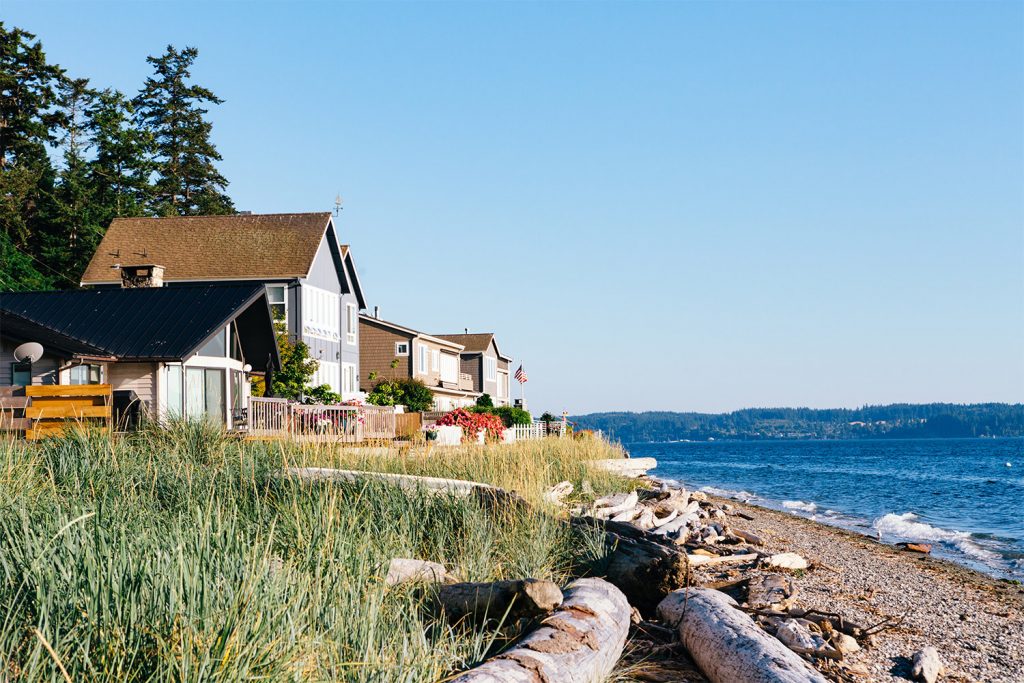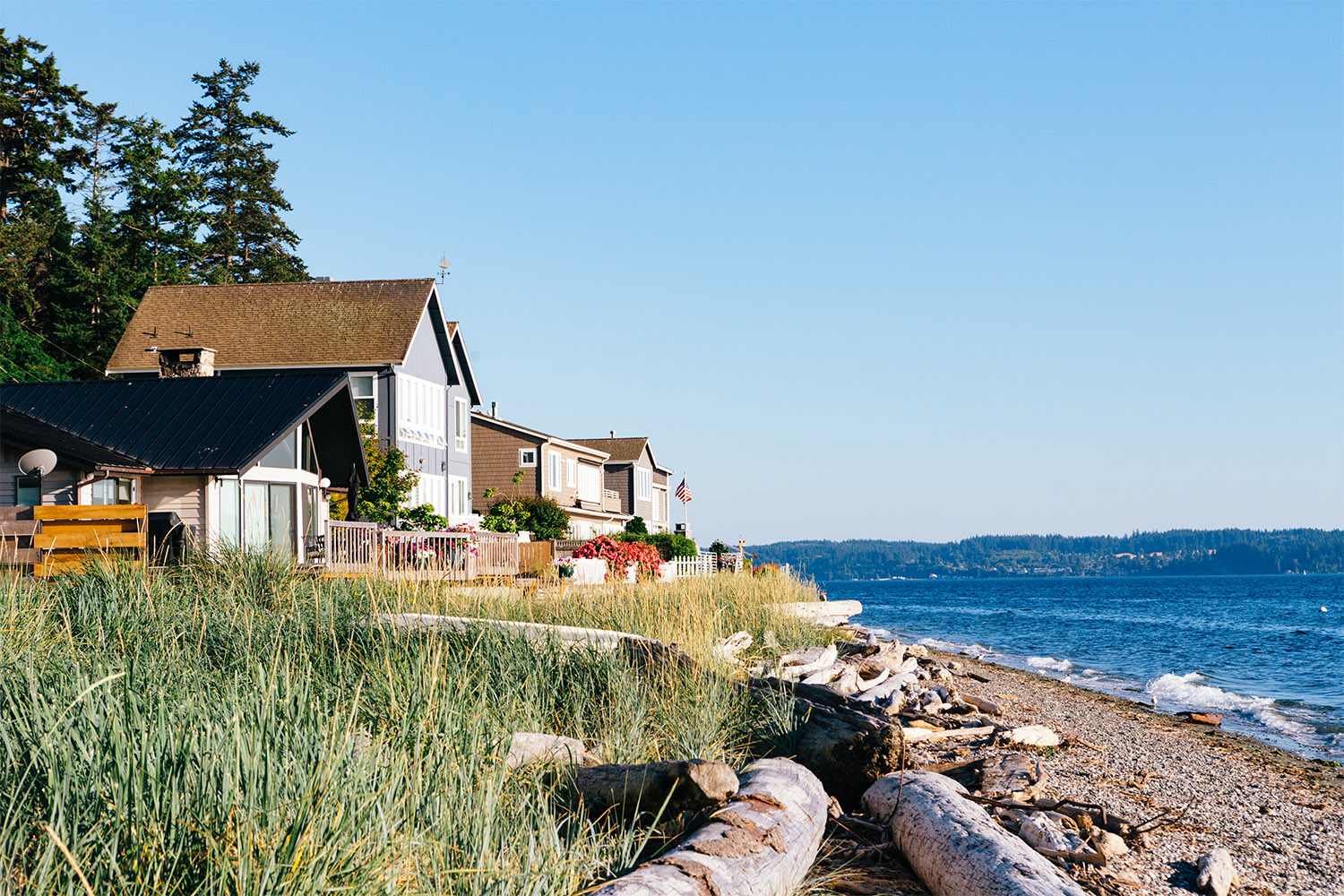
There is an unmistakable beauty to the waters of our Puget Sound. That unmatched feeling one gets from seeing the sun glisten off the salt water, the white caps be whipped up by a winter storm, or seeing our children play on the beach.
While “new” waterfront property hasn’t been made for thousands of years in our area, fortunately around the Puget Sound there are still places where you can find your slice of heaven through purchasing a waterfront home or piece of land. But for those considering moving or building close to the water, there are some very important considerations to be aware of. At the most they could be a barrier to purchasing, and at a minimum they are factors that can influence what property is the best fit for your family’s lifestyle and plans.
Let’s further explore the top tips any real estate agent should highlight with you when researching and purchasing your waterfront dream:
- Tidelands – While most of us know that the moon somehow magically makes our world’s oceans move up and down, and we may not fully understand the physics behind it, we should certainly the impact of tides on a piece of waterfront property. When it comes to real estate, there are essentially two classes of tidelands and their designation impacts ownership rights. Depending where in Puget Sound you are looking, the state could own tidelands up to “mean low tide”, impacting who physically owns the beach in front of your new home. An important step before buying is to research the specific Revised Code of Washington (RCW) tied to the location of the property in order to fully understand specific ownership of the tidelands.
- Bulkheads – If there is an existing bulkhead on a property, you must be aware of the health of the structure, as an old or poorly maintained bulkhead could lead to erosion and flooding of your yard or even home. Check if the bulkhead is made of wood (rotting), or concrete, and peek at what the neighbors bulkheads look like for clues to the overall health of the area’s infrastructure. Ultimately, a real estate agent should point you to an expert to learn more about the restrictions of restoring or building a bulkhead. If there isn’t a bulkhead in place yet, such as in high bluff or no bank waterfront, permitting to add a structure could take up to two years, and construction itself could be challenging and costly.
- Geotech Survey – When considering buying a high bluff waterfront property with beautiful, unobstructed views, it is recommended to hire a Geotech specialist to conduct a thorough survey on the health of the bluff itself. Well worth the nominal cost of the survey, Geotechs can provide specific data and forecasts on the possibility of a slide, sluffing, or other land movement that can dramatically impact your home and property. Additionally this type of report can recommend specific actions that can be taken to strengthen the bluff – something as a buyer you may request of the seller to close the deal.
- Septic Systems – As much of the remaining unbuilt waterfront property is located in rural areas not connected to a city sewer system but rather on a septic system, there can be restrictions around the size of home you can build. Soils must go through a percolation test (commonly known as a “perc test”) to determine the water absorption rate of soil, and hence the ability to host a septic system. Older cabins or homes on the waterfront may have unpermitted “bootleg” septic systems that while functional (or not!) need to be inspected before any purchase. New permits for installing a septic system are often available, with modern engineers able to provide sketches and planning for a range of alternatives that will meet the needs of often more restrictive regulations tied to waterfront locations.
- Boat Storage, Buoys, or Marinas – If you are going to live on the water, odds are that owning a boat to enjoy fishing, crabbing, or just exploring the Puget Sound is in your plans. As part of your decision process, be sure to consider and research options for boat storage including access to a marina nearby, the placing or use of buoys off the beach from your home, and even any community covenants regarding the storage of your boat in your yard or on your property. Like being stuck up a creek without a paddle, you want to have a plan for storing your boat when not in use!
- Rocky or Sandy Beach – Around the Puget Sound we have all types of beaches. From sandy, to small pebbles, all the way to big boulders covered in barnacles. When thinking about your future waterfront property, consider what you envision for your daily use of the beach. What is important to you and your family? Finding sand dollars, harvesting shellfish, or oysters…turning over boulders to find beach crabs, or even relaxing with the sand between your toes. There is something for everyone in the Puget Sound!
- Government Regulations – To protect the beauty, flora, and fauna of the Puget Sound’s shorelines, there are various state, county, or city regulations in place to ensure we have this precious resource for generations to come. That said, these types of regulations can have large impacts on your waterfront home so you should be aware of any specific to your property before purchase. Examples include around construction scale and type, septic systems (as outlined above), presence of archeological significant materials such as native burial grounds, potential of flooding and flood zones, and impacts on native species such as salmon. Some of these regulations may require additional insurance considerations or extra cost in building, so be sure to investigate and have your real estate broker connect you with further resources.
- Community Style – Lastly, and perhaps not specific to the actual piece of waterfront you have your eye on, but just as impactful to your enjoyment, is the type of community in which it is located. Each waterfront community has its own identity, and some may even change throughout the year depending on different use throughout the seasons. Some communities may have heavy boat traffic, or summertime parties (and noise), while others be known as sanctuaries for peace and quiet. Recognize what you are seeking, and consider matching your lifestyle with those of the community in which you buy to ensure everyone enjoys the beauty and adventure waterfront living can offer us all!
Waterfront living is a unique and special part of our region. With great daily rewards, and responsibilities, there is something for everyone to be found in the waters and the beaches of Puget Sound. Ask the right questions and talk to the experts when needed to ensure you find a slice of heaven for you and your family.
 Facebook
Facebook
 X
X
 Pinterest
Pinterest
 Copy Link
Copy Link

